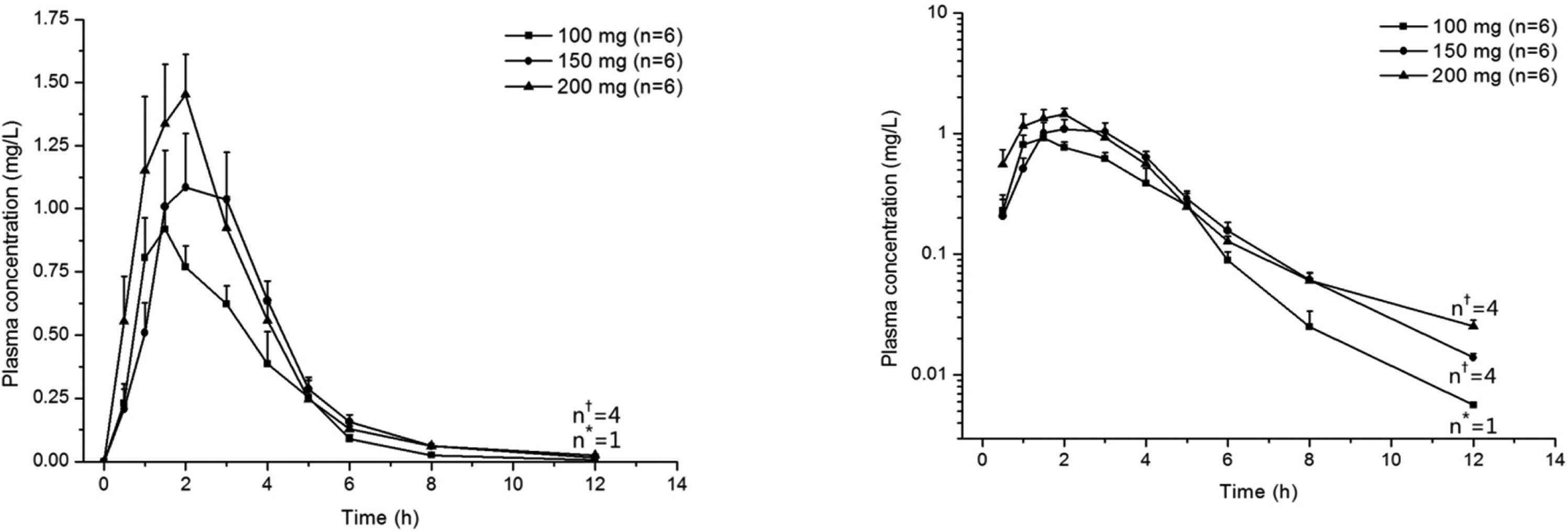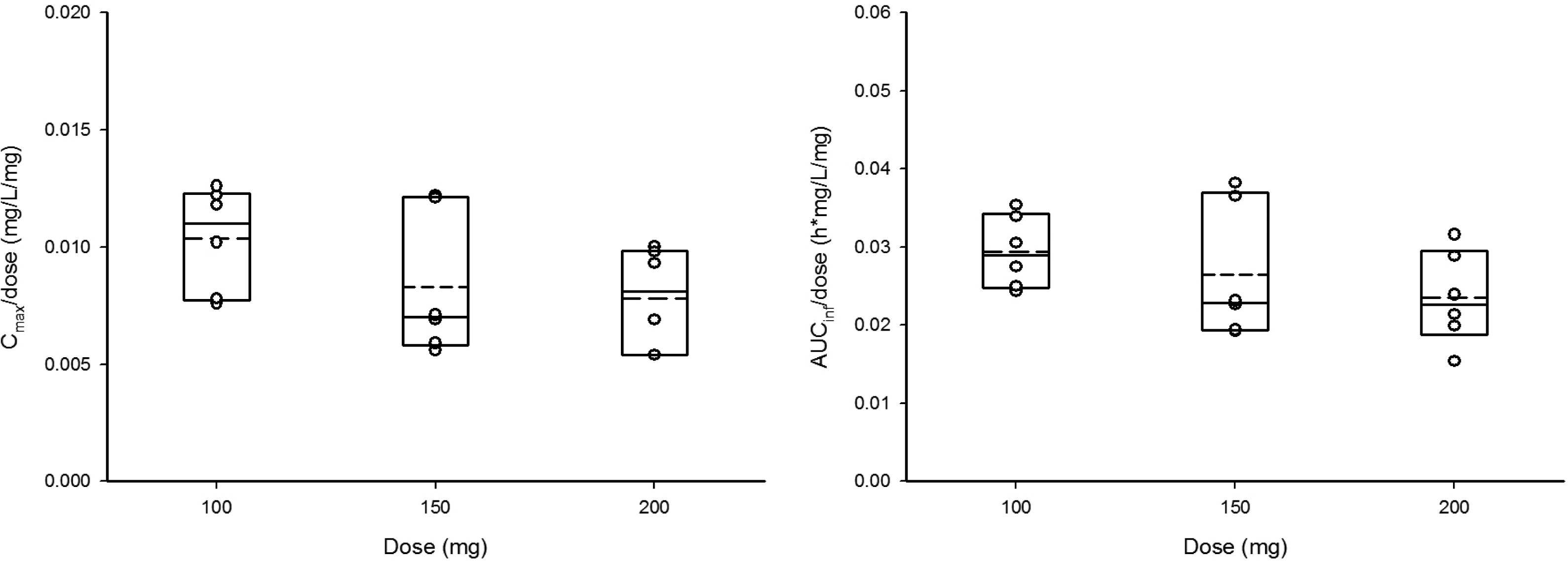J Korean Soc Clin Pharmacol Ther.
2013 Dec;21(2):104-112. 10.12793/jkscpt.2013.21.2.104.
Pharmacokinetic Characteristics of Cefcapene Pivoxil Hydrochloride after Single Oral Administration in Healthy Korean Subjects
- Affiliations
-
- 1Department of Clinical Pharmacology and Therapeutics, Seoul National University College of Medicine and Hospital, Seoul, South Korea. kslim96@snu.ac.kr
- 2Department of Clinical Pharmacology and Therapeutics, Kyungpook National University College of Pharmacy, Daegu, South Korea.
- 3Department of Clinical Pharmacology and Therapeutics, Samsung Medical Center, Seoul, South Korea.
- 4Korea Institute of Oriental Medicine, Daejeon, South Korea.
- KMID: 2203223
- DOI: http://doi.org/10.12793/jkscpt.2013.21.2.104
Abstract
- BACKGROUND
Cefcapene pivoxil hydrochloride (CFPN-PI) is an oral ester cephalosporin antibiotic with a broad spectrum. In this study, we investigated the pharmacokinetics (PK) and tolerability of CFPN-PI following single oral administration in healthy Korean subjects.
METHODS
An open label, dose escalation, parallel group study was conducted in 18 healthy male volunteers. A single dose of CFPN-PI was administered to 6 subjects in each treatment group of 100, 150 and 200 mg. Serial blood and urine samples were collected up to 12 h and 24 h after dosing, respectively. Plasma and urine concentrations of cefcapene were measured by HPLC-UV. PK parameters were estimated using non-compartmental analysis. For the safety evaluation, adverse event monitoring, clinical laboratory tests and physical examination were performed throughout the study.
RESULTS
Median values of time to peak plasma concentration were observed around 1.5 to 2.0 h. Maximum plasma concentrations (Cmax) were 1.04 +/- 0.22, 1.24 +/- 0.46 and 1.56 +/- 0.43 mg/L (mean +/- SD), and area under the plasma concentration time curve (AUCinf) were 2.94 +/- 0.46, 3.97 +/- 1.28 and 4.70 +/- 1.19 h*mg/L in 100, 150 and 200 mg dose groups, respectively. The differences of dose normalized Cmax and AUCinf among three groups were not statistically significant. The fractions of drug excreted in urine unchanged were 31.5 % - 42.9 %. There were no serious adverse events or clinically significant abnormalities related to CFPN-PI.
CONCLUSION
CFPN-PI was well tolerated with single oral administration and showed a linear PK property within 100 - 200 mg in healthy Korean male subjects.
Figure
Reference
-
1. Cazzola M. Novel oral cephalosporins. Exper Opin Investig Drugs. 2000; 9(2):237–246.
Article2. Totsuka K, Shimizu K, Konishi M, Yamamoto S. Metabolism of S-1108, a new oral cephem antibiotic, and metabolic profiles of its metabolites in humans. Antimicrob Agents Chemother. 1992; 36(4):757–761.
Article3. Neu HC, Gu JW, Fang W, Chin NX. In vitro activity and susceptibility to hydrolysis of S-1006. Antimicrob Agents Chemother. 1992; 36(6):1336–1341.
Article4. Speciale A, Caccamo F, Blandino G, Giacchi GT, Aleo G, Nicoletti G. Cefetamet pivoxil: comparable evaluation with other orally available antibiotics against selected species of respiratory pathogens. Chemotherapy. 1996; 42(1):1–10.
Article5. Choo EJ, Kwak YG, Lee MS, Jeong J-Y, Choi S-H, Kim NJ, Kim YS, Woo JH, Ryu J. In vitro antimicrobial activity of cefcapene against clinical isolates. Infect Chemother. 2005; 37(3):133–137. (Korean).6. Kuwahara K, Yokota T. S-1006, the active form of S-1108: its in vitro antibacterial activity. Japanese Journal of Chemotherapy. (in Japanese). 1993; 41(S-1):30–39.7. Nomura K, Doi M, Yoshida T. S-1108, a new oral cephem antibiotic: stability against β -lactamases and affinity for penicillin-binding proteins. Jpn J Chemother. 1993; 41(S-1):102–108.8. Saito A, Hiraga Y, Watanabe A, Saito A, Shimada K, Kobayashi H, Odagiri S, Miki F, Soejima R, Oizumi K, Hara K, Nakashima M, Sasaki S. Comparative clinical study of cefcapene pivoxil and cefteram pivoxil in chronic respiratory tract infections by a double-blind method. J Int Med Res. 2004; 32(6):590–607.
Article9. Lee JE, Han DH, Won TB, Rhee CS. A randomized, double-blinded, open label study of the efficacy and safety of cefcapene pivoxil and amoxicillin-clavulanate in acute presumed bacterial rhinosinusitis. Clin Exp Otorhinolaryngol. 2011; 4(2):83–87. (Korean).
Article10. Koga T, Rikimaru T, Tokunaga N, Higashi T, Nakamura M, Ichikawa Y, Matsuo K. Evaluation of short-term clinical efficacy of 3-day therapy with azithromycin in comparison with 5-day cefcapene-pivoxyl for acute streptococcal tonsillopharyngitis in primary care. J Infect Chemother. 2011; 17(4):499–503.
Article11. Sakata H. Comparative study of 5-day cefcapene-pivoxil and 10-day amoxicillin or cefcapene-pivoxil for treatment of group A streptococcal pharyngitis in children. J Infect Chemother. 2008; 14(3):208–212.
Article12. Nakashima M, Uematsu T. Phase I study of S-1108, a new ester-type oral cephem antibiotic. Jpn J Chemother. 1993; 41(S-1):109–125.13. Hummel J, McKendrick S, Brindley C, French R. Exploratory assessment of dose proportionality: review of current approaches and proposal for a practical criterion. Pharm Stat. 2009; 8(1):38–49.
Article14. Kato K, Shirasaka Y, Kuraoka E, Kikuchi A, Iguchi M, Suzuki H, Shibasaki S, Kurosawa T, Tamai I. Intestinal absorption mechanism of tebipenem pivoxil, a novel oral carbapenem: involvement of human OATP family in apical membrane transport. Mol Pharm. 2010; 7(5):1747–1756.
Article15. Shiba K, Yoshida M, Kaji M, Hori S, Shimada J, Sakai O. Basic and clinical studies on S-1108. Jpn J Chemother. 1993; 41(S-1):264–271.16. Aoki N, Usuda Y, Koda Y, Takasawa T, Wakabayashi N, Hayashi S, Nitta I, Kourakata Y, Watanabe K, Honma Y. Clinical pharmacology and efficacy of S-1108. Jpn J Antibiot. 1993; 46(12):1063–1074.
- Full Text Links
- Actions
-
Cited
- CITED
-
- Close
- Share
- Similar articles
-
- Efficacy of Cefcapene Pivoxil for Empirical Therapy of Acute Uncomplicated Cystitis
- In vitro Antimicrobial Activity of Cefcapene against Clinical Isolates
- A Randomized, Double-blinded, Open Label Study of the Efficacy and Safety of Cefcapene Pivoxil and Amoxicillin, Clavulanate in Acute Presumed Bacterial Rhinosinusitis
- Tolerability and Pharmacokinetics Following a Single Dose of Vardenafil in Healthy Korean Volunteers
- Evaluation of Pharmacokinetics and Tolerability of Eplerenone after Multiple Oral Doses of 100 mg in Healthy Korean Volunteers



